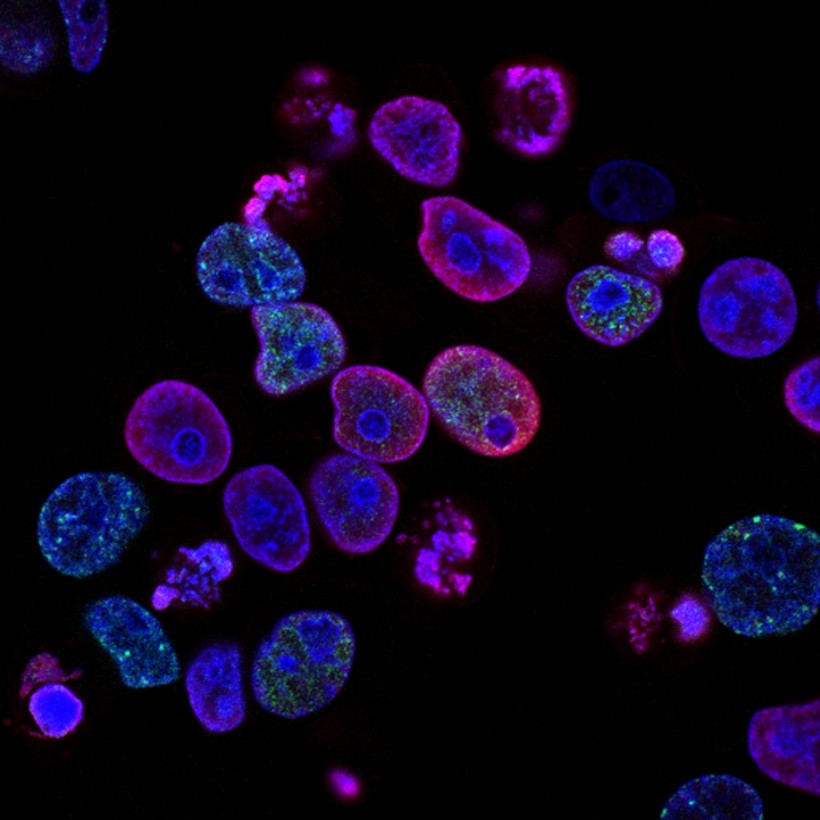Gene and cell therapies are one of the novel ways scientists have been exploring to treat diseases such as cancer. They are trying to enhance the technology's efficacy through the use of genomic safe harbors (GSHs), which are landing sites in the human genome that allows safe landing of therapeutic genes without causing unintended changes in the genome that could pose a great risk to patients.
However, GSHs are difficult to find, similar to finding a good spot for a lunar landing. That is why scientists from Harvard's Wyss Institute for Biologically Inspired Engineering, Harvard Medical School (HMS), and the ETH Zurich in Switzerland have developed a computational approach to identify GSH for the higher potential of safe insertion of therapeutic genes.

Human colorectal cancer cells treated with a topoisomerase inhibitor and an inhibitor of the protein kinase ATR (ataxia telangiectasia and Rad3 related), a drug combination under study as a cancer therapy. Cell nuclei are stained blue; the chromosomal protein histone gamma-H2AX marks DNA damage in red and foci of DNA replication in green. Created by Yves Pommier, Rozenn Josse, 2014
Identifying GSH Sites
GSHs are sites in the genome that accommodate the integration of new genetic material that ensures it will function predictably, do not cause alterations of the host cell. According to Phys.org, GSH has to be accessible to genome editing techniques, does not have physical obstacles, and allows high, stable, and safe expression of the therapeutic gene.
Using the available sequencing data from human cell lines, the team developed a computational approach to predict regions in the genome for GSHs. Study first author Erik Aznauryan, Ph.D. said that this method helped them scan computationally excluded regions that encode proteins responsible for cancer tumors and those types of RNAs with functions in gene expression and cellular processes.
He added that they were also able to eliminate regions that contain enhancer elements to activate the expression of genes and the centers and ends of chromosomes to avoid mistakes in replication and segregation of chromosomes during cell divisions. In the end, they were left with 2,000 candidate loci which they investigated further.
They randomly selected five of these identified GSH sites and inserted reported genes to each of them using a rapid and efficient CRISP-Cas9-based genome strategy. They found that two of them allowed high expression of the inserted reporter gene and did not upregulate any cancer-related genes.
Aznauryan explained that this is possible because regions in the genome are distant in the linear DNA sequence of chromosomes. On the other hand, the 3D genome has regions of folded chromosomes touching each other, which can be affected when there is an additional gene inserted.
ALSO READ: 64 New Human Genomes Revealed, Expected to Better Reflect Genetic Diversity
Identification of More GSH Sites Lead to More Advanced Cellular Therapies
The team also investigated the two GSH sites found in immune T cells and skin cells. According to the American Cancer Society, T cells are used in adoptive cell therapies for cancer treatments and a cure for autoimmune diseases.
In a similar report from News Medical Life Sciences, researchers noted that skin diseases due to harmful genetic mutations could be treated by inserting a healthy copy of the mutated gene into a GSH of dividing skin cells that replenish those layers. They introduced a fluorescent reporter gene into the two new GSHs in the T cells extracted from the blood and the LAMB3 gene into the GSH in dermal fibroblasts.
They found that insertion has minimal potential for promoting tumor growth, which is always the primary concern when genetically modifying therapeutic genes. Researchers said that the identification of multiple GSH sites supports the potential in building more advanced cellular therapies relevant in T cell engineering for cancer immunotherapy.
RELATED ARTICLE: Breakthrough Cancer Treatment Points to Common Herbs in Suppressing Tumor Growth
Check out more news and information on Medicine & Health in Science Times.














